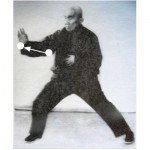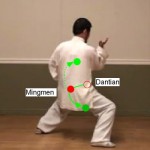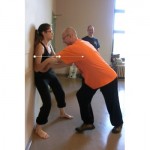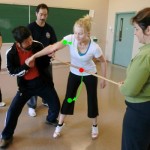I would like to thank the Ottawa group for organizing a great workshop. During the workshop, we practice Yilu and the foundation exercises. An important component of the workshop is understanding the theory and philosophy of Chen Taijiquan. Master Chen covered many concepts but I will only highlight the idea of “Connecting Pairs” and “Clear”
Connecting Pairs
Pair Matching or Connecting Pairs is a basic concept in the Practical Method. The idea can be understood by applying the concept to a line. In a line, there is always a pair since each end represent the Yin and the Yang section respectively. In Taiji training we need to create such matching pairs between body parts and we use the phrase “Yin-Yang must be equally split”. Why is this concept so difficult to apply? Such movements are not normal and therefore mentally, we do not believe in this principal. Instead, the body wants to move – to react. Such movement will break the principle of connecting pairs. The Taiji method is simple, don’t move the connecting pair but move something (anything) else. To illustrate this concept, Master Chen suggests the following exercises: 1) Connecting the elbow to the hand (2) Connecting the Dantian to the Mingmen (3) Push against a wall.
1. Connecting the elbow to the hand
. In drawing the positive circle, link the elbow to the hand. This is accomplished by stretching the hand and not moving the elbow during one move of the positive circle. An example of this stretch is illustrated by the picture of Grandmaster Hong. The elbow is stationary but the hand reaches out. The movement is probably very small but the importance is the intention.
2. Connecting the Dantain to the Mingmen
An important connecting pair is the Dantain (丹田) and the Mingmen (名门, GV4) – two meridian points important in traditional Chinese medicine. This exercise is performed by moving the Mingmen and the Dantain together. This is achieved by squeezing in the stomach and tilting the tailbone. When you can feel this connection, then you can continue the exercise with a Yin-Yang separation about this connecting pair. This separation is achieved by suspending the head and dropping the bottom. This exercise can be seen in the picture of Master Chen.
3. Push against a wall
The practical method training proceeds from the real to the unreal. The beginner needs to learn to connect two physical (points) before you can start to connect points that are not real (imagined). The wall exercise is a method to achieve this understanding. In the picture, your friend (in orange) pushes and pins you (in black) against the wall. You have to find a point on the wall and connect it with your hand to move your opponent away. The wall provides you with a real restriction so that you can find and establish this connection pair. This exercise has a direct application in push hands. You imagine a wall, find the point on this imaginary wall and connect it with your hand to move your opponent away.
Clear
Clear is a concept arising from the philosophy of Ying-Yang Separation. Its importance is pointed out by both Grandmaster Hong and Chen Xin through the phrase: “The elements of surprise reside in the turning of the joints.” (“得势争来脉, 出奇在转关。”) Master Chen uses a practical exercise to demonstrate this idea.
A fix bar is used to establish a line where the body (in white) cannot move past. The point of contact between the fix bar and the body establish a point. Your opponent (in black) can try to pull you closer and closer but at some point there is limit to how close the body can move towards the bar. At that instant, if you give up the top and bottom for example, by stretching over the point, your opponent will fall into emptiness. This is a practical illustration of the concept of “turning of the joints”. This point or moment in time can be understood as a inflection point in mathematics or critical phenomena in physics.
Musings
The Mandarin Duck (yuān yāng; 鴛鴦) can be use as a metaphor for the concept of “Connecting Pair”. This poem demonstrates that human relationships also exhibits this Taiji concept.
古詩十九首
客從遠方來 遺我一端綺
相去萬餘里 故人心尚爾
文彩雙鴛鴦 裁為合歡被
著以長相思 緣以結不解
以膠投漆中 誰能別離此







